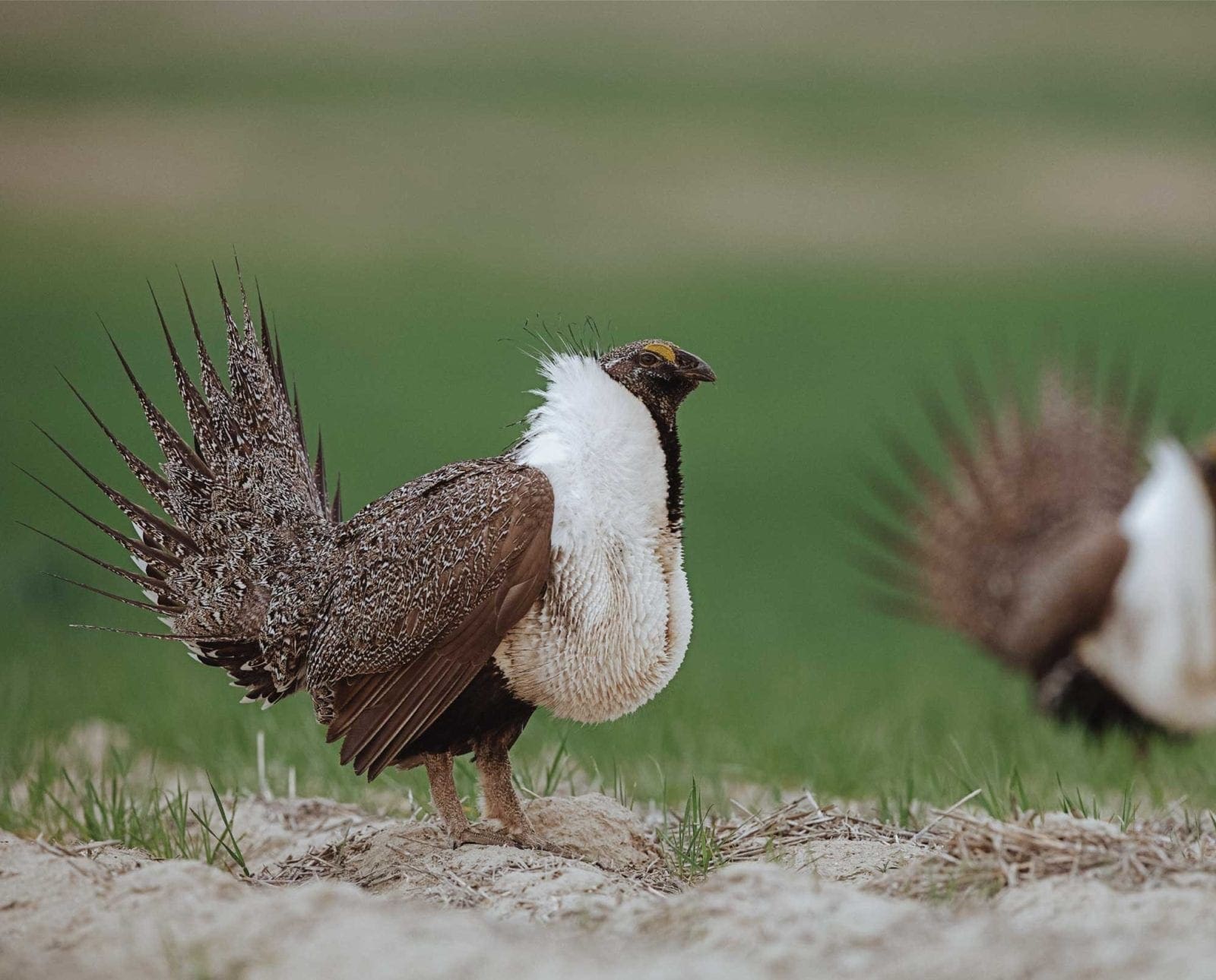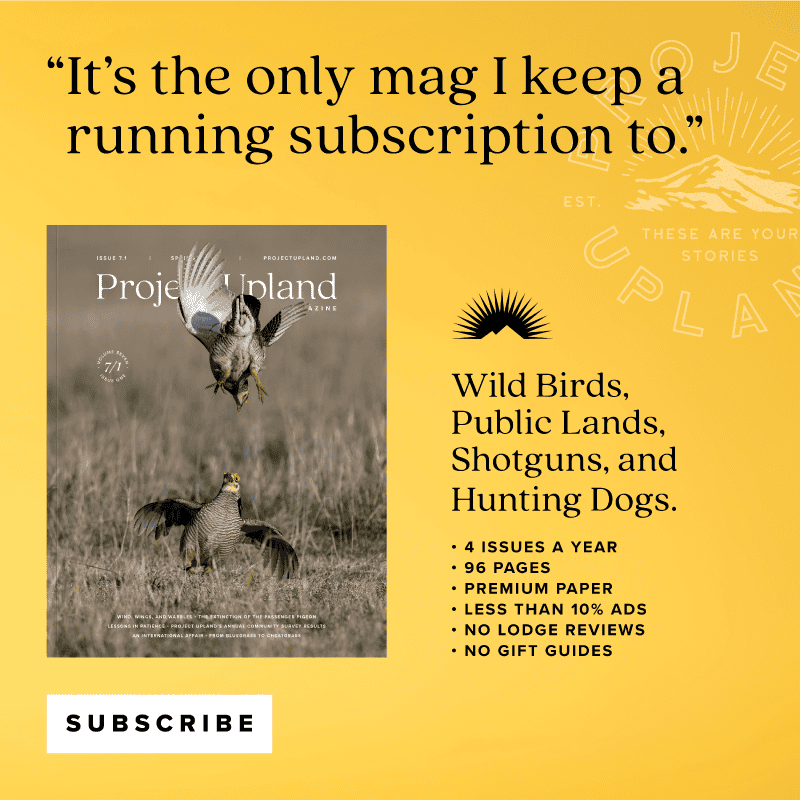Home » Grouse Species » Sage Grouse Hunting » Greater Sage-Grouse (Centrocercus Urophasianus) – A Game Bird Profile
Greater Sage-Grouse (Centrocercus Urophasianus) – A Game Bird Profile
- Climate Change Impact (Audubon) | +1.5°C - 66% Range Lost | +3.0°C - 94% Range Lost

Ryan Lisson is a biologist and regular content contributor to…
America’s iconic and largest grouse species hailing from the West
If you are from the western half of the country, you are no doubt familiar with the Greater Sage-Grouse. This iconic and immediately recognizable bird is one that hails from the central sagebrush flats of our country. It is the largest grouse species in North America – larger even than its close cousin, the Gunnison sage-grouse (Centrocercus minimus), which is slightly different looking and endemic to small portions of Colorado, Utah and Arizona. Habitat loss and climate change have steadily decreased populations of the Greater Sage-Grouse and placed them in the conservation spotlight over the last few decades. Here are some interesting facts about the Greater Sage-Grouse.
Description and life history of the Greater Sage-Grouse
As mentioned, the Greater Sage-Grouse is a large grouse species that weighs in at about 7 pounds (NatureServe 2018). Females have generally plump bodies but typically have a small head. Their feathers are mostly mottled or speckled brown, gray and cream. Their stomachs are darker brown or black in color, which can be observed from the side profile as well. They also have long, sharp tails and large bills. The males share some of these characteristics (e.g., long tails, small heads, back and stomach colors, etc.), but are very different looking in several other aspects. For example, their most noticeable feature is their throat sac. Below their black throat are two yellow air sacs surrounded by white feathers (resembling a sunny-side-up egg) that can be inflated during courtship to produce a gurgling call (All About Birds 2018). Their tail feathers taper to a sharp point and are often fanned during courtship. Additionally, they have a yellow comb above each eye and a plume of feathers extending from the back of their heads. All in all, a displaying male is a quite a sight to see!
Like the Sharp-tailed Grouse, male Greater Sage-Grouse participate in an extraordinary courtship display each spring. Large numbers of males gather at a lek site to display for females – up to 400 males may congregate in a large and high quality lek (NatureServe 2018). Males puff out their chests, raise their wings slightly and fan their pointed tails into a starburst behind them. Throughout their display, they thrust their heads and breasts forward, producing a gurgling, bubbling, unearthly call. They aggressively compete for the best central location of the lek site. Females gather in the lek sites to choose a mate and usually select the largest and best displaying males (National Audubon Society 2018). After mating, females scratch a depression into the ground below sagebrush or a clump of grass and line it with vegetation, twigs or breast feathers. In this nest site, the female will usually lay 7 to 9 eggs and incubate them for 25 to 27 days (National Audubon Society 2018; NatureServe 2018). The hatched chicks are able to feed themselves and fly within a very short time period.
Greater Sage-Grouse chicks consume mostly insects (e.g., ants, beetles, grasshoppers, etc.) for their protein content (NatureServe 2018). In addition to these insects, adults also consume shoots, leaves, flowers and buds of various plants (mostly sagebrush and forbs) throughout the spring and summer (NatureServe 2018). In the fall and winter, Greater Sage-Grouse switch their diet to almost entirely sagebrush leaves and can actually gain weight on such a modest food source during this harsh time (NatureServe 2018; All About Birds 2018). True to their name, their digestive systems specialize in consuming sagebrush, but they are unable to digest hard seeds like most other grouse species (All About Birds 2018).
The Greater Sage-Grouse is preyed upon primarily by large raptors (e.g., golden eagles) and coyotes, although ravens, skunks, badgers, raccoons, weasels, bobcats and snakes are very effective nest predators as well (Lockyer et al. 2013). If a hen is surprised on her nest, it will often flap its wings and pretend to be wounded to distract the predator from the nest. However, if it notices a predator approaching from farther away, it will often flush and act like a hen without a nest or brood to throw the predator off the trail (NatureServe 2018).
Range and habitat of the Greater Sage-Grouse
The Greater Sage-Grouse used to occur throughout the central and west central United States (overlapping the Greater Prairie-Chicken range) but its range has been restricted to 56 percent of that pre-settlement distribution (NatureServe 2018). They are currently thought to be secure in Wyoming and Colorado, but vulnerable, imperiled, or extirpated (locally extinct) in most of the surrounding states.
As mentioned, the Greater Sage-Grouse is a creature of the sagebrush plains and areas where sagebrush is the predominant plant community. This includes mountain slopes and foothills, open plains and rocky mesas (NatureServe 2018; National Audubon Society 2018). In addition to sagebrush flats, prime nesting habitat is usually located in riparian areas, wet meadows, willow shrublands or even in pastures and crop fields where insects are abundant and cover is adequate.
READ: How to Identify Sage Grouse Habitat
Areas with several species of sagebrush, rabbitbrush, greasewood, juniper, and quaking aspen are also used for nesting sites (NatureServe 2018; National Audubon Society 2018). Lek sites are usually located in clearer areas with closely cropped vegetation such as recently burned areas, exposed and flat ridgetops, dry lakebeds or pastures (All About Birds 2018).
Conservation issues for the Greater Sage-Grouse
The Greater Sage-Grouse used to be a very abundant bird species in our country. However, habitat loss and fragmentation have steadily taken their toll on populations, with a 3.5 percent decline each year between 1966 and 2015 (All About Birds 2018). They are extirpated or vulnerable throughout much of their former range, but are stable in Wyoming and Colorado (NatureServe 2018). The estimated global breeding population is now only 150,000 birds, with about 94 percent occurring in the United States and the remainder occurring in Canada (All About Birds 2018; BirdLife International 2016).
The primary habitat threats to Greater Sage-Grouse include habitat conversion to agriculture, overgrazing of cattle and development. Even small habitat changes (e.g., installation of utility lines, fencing or roadways) can have a measurable impact on populations and reduce lek attendance (All About Birds 2018). As such, Greater Sage-Grouse may be threatened by energy development projects and even the introduction of invasive plants (National Audubon Society 2018).
But all that doom and gloom aside, the U.S. Fish and Wildlife Service determined in 2015 that protection for the Greater Sage-Grouse under the Endangered Species Act was no longer warranted and that the species did not face the risk of extinction now or in the foreseeable future. Thanks to several multi-agency or multi-organization efforts across the sage grouse range, the species seems to be stabilizing or even making small comebacks.
Hunting opportunities for the Greater Sage-Grouse
There are only a few states where you can hunt Greater Sage-Grouse at this time. For many of these hunts, you’ll also have to apply for a special permit. The states, season dates, and possession limits are listed below. Note that the season dates and limits may change, so always be sure to study the hunting regulations.
| State | Season | Season/Possession Limit |
| California | CLOSED | CLOSED |
| Colorado | September 9-September 15, variable units | 2-4 birds, variable units |
| Idaho | September 16-September 22 | 2 birds |
| Montana | September 1-September 30 | 4 birds |
| Nevada | September 16-October 8, variable units | 4 birds |
| Oregon | September 9-Septmber 17, variable units | 2 birds |
| Utah | September 30-October 22, variable units | 2 birds |
| Wyoming | September 16-September 30, variable units | 4 birds, variable units |
If you are lucky enough to draw a permit (where required), be ready to work for a sage grouse. The hunting approach that most people agree on is to find a higher area from which to glass sagebrush plains. After locating a group of sage grouse (or even an individual), try to sneak in from the downwind side. Being large birds, they are fierce flushers and can reach speeds of up to 50 mph once they get going—be prepared to make a quick shot and lead them enough to connect. If you can successfully bag a bird, especially a beautifully adorned male, take the time to appreciate how rare and special that opportunity is. Most people will never know that experience unless things drastically turn around for this species.
Read: Four Tips for Better Sage Grouse Hunting
Sources
All About Birds. 2018. Greater Sage-Grouse. Accessed at: https://www.allaboutbirds.org/guide/Greater_Sage-Grouse/lifehistory
BirdLife International. 2016. Centrocercus urophasianus. The IUCN Red List of Threatened Species. Accessed at: http://www.iucnredlist.org/details/22679503/0
Lockyer, Z.B., P.S. Coates, M.L. Casazza, S. Espinosa, D.J. Delehanty. 2013. Greater Sage-Grouse Nest Predators in the Virginia Mountains of Northwestern Nevada. Journal of Fish and Wildlife Management 4(2):242-254. Accessed at: http://fwspubs.org/doi/pdf/10.3996/122012-JFWM-110R1?code=ufws-site
National Audubon Society. 2018. Guide to North American Birds. Accessed at: http://www.audubon.org/field-guide/bird/greater-sage-grouse
NatureServe. 2018. NatureServe Explorer: An online encyclopedia of life. Accessed at http://explorer.natureserve.org
Ryan Lisson is a biologist and regular content contributor to several outdoor manufacturers, hunting shows, publications, and blogs. He is an avid small game, turkey, and whitetail hunter from northern Minnesota and loves managing habitat almost as much as hunting. Ryan is also passionate about helping other adults experience the outdoors for their first time, which spurred him to launch Zero to Hunt, a website devoted to mentoring new hunters.





